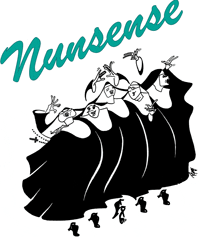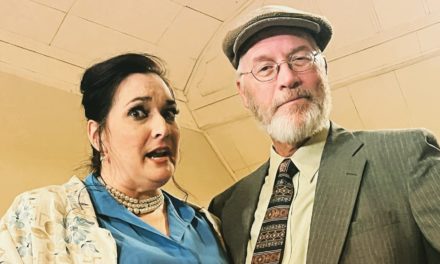CEDAR CITY — Long before the Book of Mormon smashed it’s way on to Broadway, there was another religiously themed musical with much more modest origins. Nunsense, a 1985 musical by Dan Goggin, began as a series of greeting cards, and quickly evolved into an entire musical franchise. With a television adaptation, 6 sequels and 3 spin-offs, Nunsense has established itself as one of the most popular niche theatre productions in history.
The key word is “niche. “Nunsense is the story of a few habited sisters putting on a variety show to raise money after a cooking accident wiped out 52 members of their convent. As can be expected from a show with such a silly premise, the piece is filled with puns (the last deadly meal was cooked by Sister Julia, Child of God), ludicrous scenarios (like the Mother Abbess getting high off some confiscated drugs), and a wide range of habit humor.
The Heritage Theater is a large venue that can easily swallow a production, but co-directors Chrystine Hyatt and Desiree Whitehead have assembled a cast that admirably energizes the story. Lauretta Swansborough is the highlight of the show as Sister Mary Amnesia, a devoted sister who suffered a blow to the head with a crucifix, causing her to lose all memory of her past identity. Swansborough has a clear high soprano voice and the comic chops to portray her character’s forgetfulness in manner that isn’t completely over the top. In one scene she describes why she loves being a nun during a duet between herself and a vulgar hand puppet, switching from her high voice to a gruff alto. She manages the audience well in an interactive pop quiz, helped by a hysterical little assistant played by Aubree Christensen. Without saying a word, Aubree Christensen got more than a few laughs from me with her speedy mincing walk, and I wish I could have seen her more throughout the evening.
Jane Williams is appropriately authoritative and gruff as Sister Mary Regina, a former circus performer turned Mother Abbess, and is balanced nicely by Barb Christensen as the overwrought mistress of the novices. Neither have particularly strong singing voices, which is particularly exposed in their duet “Just a Couple of Sisters,” but yet both have a strong enough stage presence to carry them through the evening.
Cathy Ford is comically sunny as Sister Mary Leo, a nun with aspirations of becoming a ballerina. The funniest scene of the evening is Leo’s ballet re-enactment of the nuns deaths by food poisoning, but Ford also shines in her solo number “Benedicite.” Brooke Bang is a strong presence as Sister Robert Anne, a street-wise teen turned nun who longs for the stage but is relegated to the understudy role. Bang navigates the Brooklyn accent well and delivers a great performance in her showy solo “ I Just Wanna Be a Star.”
Individual numbers were generally better than group numbers in this production. Each cast member had a solo or two they carried well, but when singing in unison the group often lost the rhythm or clashed on harmonies. The choreography was repetitive with a few too many chorus line, and was unpolished and frequently out of sync. In a few cases this was an intentional choice (Sister Amnesia frequently lost her way in the middle of numbers), but in a lot of cases looked sloppy as cast members would do completely different variations of the movement in dances that were meant to be unison. The show lacked a credited choreographer and a music director, which perhaps explains why these areas were less polished.
The show was, like the other two shows I saw at the Neil Simon Festival, very slow to get going. The nuns slowly walk in goggling at the audience, then introduce themselves, then finally move into the sloppy opening number “Nunsense is Habit Forming.” The show picks up the pace after that as different characters have a chance to shine, but is difficult to get excited after a drawn out opening. Hyatt and Whitehead’s blocking is adequate, but missed opportunities to better tell the story. For example, in “A Difficult Transition,” the nuns tell the story of how they arrived at their abbey (a very confusing story), and some clearer blocking would have helped the audience follow the story better. However, the directors did a nice job of keeping the movement going. Nunsense never really paused, and scenes transitioned smoothly from one number to the next.
Nunsense is not designed to tell a story or prove a dramatic point, but instead to make the audience laugh. While this production produces more chuckles than hysterics, the cast is pleasant and talented and might be worth see for readers who can appreciate a good religious pun.






